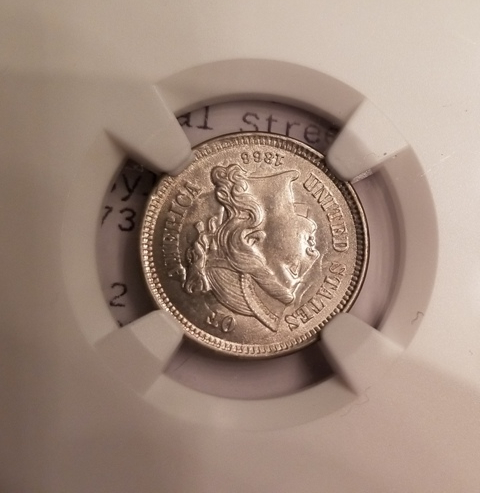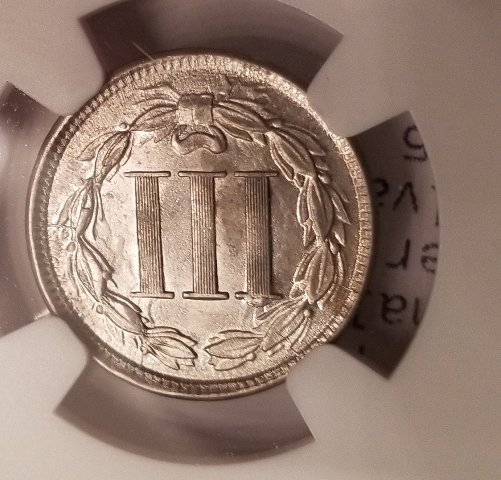Three Cent Nickel opinion
It's been a while since I posted here. For the three cent nickel experts, I picked this up last week and would like your opinion. I am no expert at all. It will be liberated from it's prison soon to reside in my Dansco 7070.


US Navy CWO3 retired. 12/81-09/04
Looking for PCGS AU58 Washington's, 32-63.
Looking for PCGS AU58 Washington's, 32-63.
0
Comments
Yes. It's a 3 cent nickel.
What are you actually asking?
All comments reflect the opinion of the author, even when irrefutably accurate.
What would you grade it?
Looking for PCGS AU58 Washington's, 32-63.
Is that a die clash under the chin on the obverse? Cheers, RickO
It's upside down.
Looks like a nice coin. Yours has an internal die chip on top of one of the columns that make up the "III". I had a similar coin. Looks like someone's brain lying there. If you look through CoinFacts you'll see a few other examples and you can even get an idea of progression of this die issue over time.
Lots of clash marks as is common on these.
It looks to have rather strongly clashed dies, which isn't unusual in my experience for this series, and also perhaps was struck from rusted dies, as well. I would offer one caution about this coin and that is when and if you decide to sell it that you may have a harder time with it as a raw coin because some will regard the rusted dies as environmental damage or something similar.
In honor of the memory of Cpl. Michael E. Thompson
A good choice for a Dansco Album.
Thanks for the opinions. I thought it was better than the MS61 grade assigned by NGC but then again, I'm no expert on these.
Looking for PCGS AU58 Washington's, 32-63.
Nice looking coin.
My YouTube Channel
I like this piece because it refects the history of problems that the Philadelphia Mint had making these coins. The clashed dies show one aspect of the production probems, and the heavy rust on the reverse shows what could happen in the humid Philadelphia climate if the mint employees weren't careful.
I once had an 1865 Nickel Three Cent Piece that was similar to this. I wish today that I had kept it.
I find grading coins upside harder, but my grade would be MS-64. If would not surprise me if NGC called it an MS-65.
It's also from the very rare inverted dies variety.....
I have had situations where I have rotated my photos with the software, and it still comes up here still rotated in the wrong direction. Lets see what happens with this one.
Here is the 1865 Nickel Three Cent I sold years ago.
It really is hard to evaluate a coin that is upside down....I'm not sure why.
But I will say that's a pretty nice strike. The lower curls of the hair is often fairly weak, along with the vertical lines on the reverse roman numerals.
61 does seem a bit harsh...but maybe the spotting and die erosion on the lower reverse, along with the clashing, got dinged for eye appeal. Still, if you happen to be a "strike fan", it's a really nice choice.
I kind of thought it might get a upgrade to AU58.
Pretty cool!
I looked through CoinFacts (3cn 1866), and I found 8 examples of this die chip (2 small, 6 large), plus 2 more examples of the reverse before the chip (with the same reverse cracks).
All these were paired with the same obverse die, also in various die states.
http://www.pcgscoinfacts.com/CoinImages.aspx?s=3732
Thanks as always to PCGS for providing such an excellent resource.
I believe it is die erosion rather than die rust which created the irregular outer surfaces on all the examples with the chip, but I'm not sure.
I checked Allan Gifford's book ("The Ultimate Guide to U.S. Three Cent Nickels 1865 to 1889"), and the Fletcher - Flynn book,
but both books are focused on RPDs and DDOs. Strangely, Gifford's book uses separate pages for unclashed, single clashed, double clashed, etc. for each die pair. But it virtually ignores die cracks. Yet this pattern of die cracks identifies the most frequently found die pair for 1866! It is listed in the cud book as TCNC-1866-8R. It's somewhat sad there does not exist a 3 cent die variety book which identifies common and easily classified varieties like this.
I have had situations where I have rotated my photos with the software, and it still comes up here still rotated in the wrong direction. Lets see what happens with this one.
Same here, I can rotate it with the software and it still comes out upside down when posting.
Looking for PCGS AU58 Washington's, 32-63.
I believe what is going on is that .JPG files have a field (in their EXIF header) which specifies rotation.
Some image editing software will just alter a few bits in that field if you use their rotation command,
and the image will appear rotated in the editing software.
However, some image display software such as your browser may ignore the rotation field.
There should be a way around it. I use the IrfanView editing software (free, Windows-only),
and rotations show up correctly in my browser.